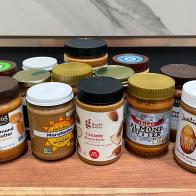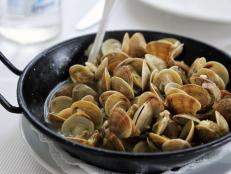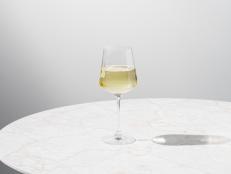Are Natural Wines Really Healthier?
If you’re seeking out these bottles for more than just flavor, here’s what you need to know.

UliU/Getty Images
Natural wines have been touted as less likely to cause hangovers, made with fewer pesticides and sulfites, and even packed with healthy probiotics. But how do these claims stack up? Is it true that natural wines are healthier?
What Is Natural Wine?
There is no official definition for a natural wine. But when we asked this question at a wine superstore, and at a small local wine shop, we got an answer similar to what we also heard from a master sommelier. Andrey Ivanov, Master Sommelier and President of Bliss Wine Imports & Concierge described natural wines as having most or all these characteristics:
Made with Organic Grapes: The wine bottle may have the USDA Organic seal. This certification is expensive, especially for winemakers of imported wine because the Organic certification must be resubmitted each year, making it time and resource draining. So even if a wine is made with organically grown grapes, the word “organic” may not appear on the label. Another clue to finding a natural wine is looking for the word “biodynamic” which means the grapes were farmed in a closed ecosystem, using more holistic practices and careful attention to detail.
Dry Farmed: These grapes are watered by rain, not irrigation. This water-saving agricultural technique is most common in Europe and some other parts of the world where rainfall is reliable.
Made with Native Yeasts: Yeasts occur naturally on grape skins – or in the air at old historic wineries – and are used in fermentation instead of yeasts cultured in a lab.
No Additives Added: Except a few sulfites remaining from fermentation, which are necessary to keep the wine from re-fermenting.
Ivanov points out that in the last 15 years, most wineries in the U.S. and around the world have organically shifted their practices toward making wines that are “more natural.” He says many wineries, especially smaller producers, are returning to a more historical way of making wine for the region in which they are located or the grape varietals they are using. “This is a good shift for the industry, but the best way to find natural wines is to make friends with a local wine shop owner, or purchase them from online retailers.”

visualspace/Getty Images
But what if you don’t live near a knowledgeable wine shop – or you need a bottle at the last-minute? It can be difficult to find a natural wine just by looking at the label on the bottle. But Ivanov says you may be able to get a wine that’s “more natural” or contains some of the above characteristics by looking for several of the following:
USDA organic certification or the European Union, Australian or international equivalent
“Demeter Certified Biodynamic” on the label. This is the world standard.
A pét-nat wine: This style of wine, pétillant naturel, is by definition natural. And the slightly sparkling wine may be a fun place to start exploring natural wines. Another typically natural choice is Beaujolais.
A price tag of $20 to $30: Ivanov says the economics just don’t make sense for a wine to be less than $20 and still compensate for the extra work necessary to make a wine natural.
But is this price tag worth it? Do natural wines stack up against claims of being “healthier?”

wilatlak villette/Getty Images
Are Natural Wine Grapes Grown with Fewer Pesticides?
Probably. If the grapes are organic, certain chemicals can still be used, but they must be organic pesticides, fungicides and herbicides. And in general, organic winegrowers tend to use fewer chemicals because there are fewer organic chemicals available to them.
Most natural vineyards tend to have a more organic-biodynamic growing philosophy.
Do Natural Wines Contain Fewer Sulfites?
Some people have described having headaches from sulfites in wine, although headaches can also result from alcohol, sugar or other additives.
All wines contain naturally occurring sulfites. But some winemakers add additional sulfites during winemaking, mainly as a preservative.
All wines sold in the U.S. must state “contains sulfites.” But there’s no way to tell how much, if any, additional sulfites have been added during winemaking – unless a winemaker applies for a “no added sulfates” label by going through an expensive yearly review.
Ivanov says in general, natural wines contain fewer sulfites. He suggests contacting the vintner for confirmation.
Do Natural Wines Contain Fewer Additives?
Generally, yes.
Wines may contain one or more of 60 additives and only sulfites need to be listed on the bottle. Natural wine makers generally do not use additives beyond a few sulfites which are necessary to keep the wine from re-fermenting in the bottle.
But many of the additives have a purpose in modern wine-making and Ivanov points out that most smaller vintners are moving toward a more ‘natural’ process with fewer additives.
Are Natural Wines Lower in Sugar?
Natural wines do not contain added sugar.
But even if sugar is added to a wine – as it is in the traditional Champagne method – this sugar is usually completely consumed by yeasts during fermentation, making the wine ‘dry.’
“Most wines are dry. But wines do contain different levels of alcohol and thus calories. People sometimes confuse sugar with calories in wine. A higher percent ABV [alcohol by volume] means a wine will have more calories than a lower ABV wine,” explains Ivanov.
Are Natural Wines Lower in Alcohol?
They can be. But the alcohol content depends mainly on the type of wine.
Typically, you find natural wines in the 11 to 13-percent ABV range for whites, and 11.5 to 13.5-percent for reds, but sometimes reaching 14-percent and above in hot climates, explains Ivanov.
Do Natural Wines Cause Fewer Hangovers?
That depends mainly on how much you drink.
Natural wines tend to be lower in alcohol by volume, so you may end up consuming less alcohol, and thus have fewer hangover symptoms. Of course, experts agree that the best way to avoid hangovers is to drink responsibly.
Do Natural Wines Contain Probiotics?
Maybe, but the amount is so small, it won’t have much impact on gut health.
The sediment in the bottom of natural wine bottles may contain tiny amounts of probiotics. But the wines also contain very little sugar because it has been consumed by yeasts during fermentation. Thus any probiotic good bacteria leftover from fermentation would not have any sugar for long-term nourishment and survival in the bottle.

Alberto Gagliardi/Getty Images
Bottom Line: Some characteristics of natural wines, like lower alcohol content, may be relatively healthier if the wine is consumed in moderation. Natural wines also tend to have fewer additives. But wine isn’t inherently healthier because it’s natural. However, it is often much easier to research how a particular natural wine is made – because these vintners publicize their unique production methods and their increased scrutiny for quality control. If there are certain characteristics of natural wines, like organic grapes and farming practices, that are important to you, find a wine shop or online retailer with knowledgeable staff and ask questions, as many quality wineries are moving toward a more ‘natural’ way of winemaking, even if they don’t call themselves a “natural wine.” Just be willing to pay at least $20 or so for that level of quality.
Related Content:






























